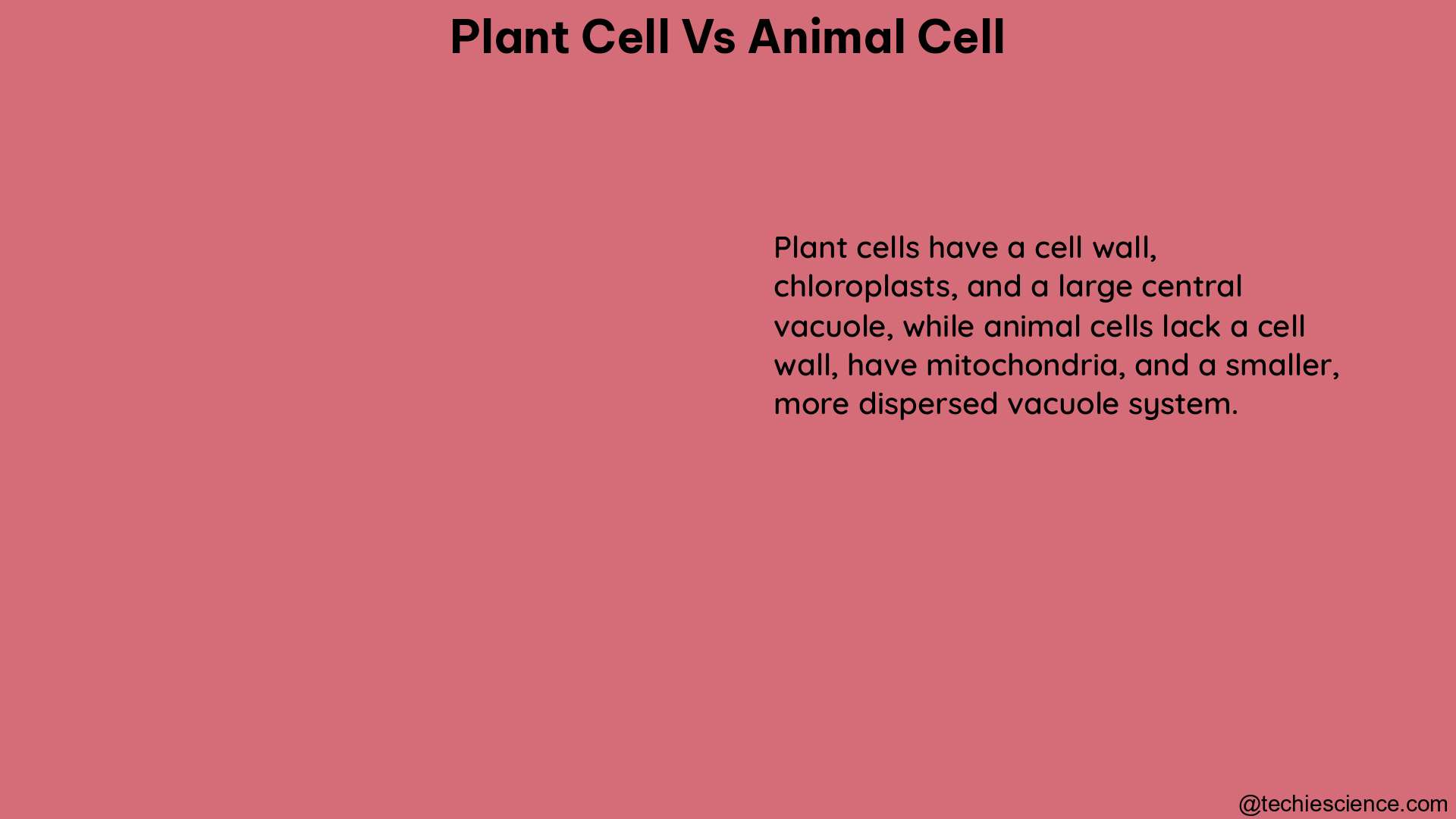Plant cells and animal cells are the fundamental building blocks of life, but they differ in several key aspects. This comprehensive guide delves into the intricate details of plant cell and animal cell structures, organelles, and mechanical properties, providing a deep understanding of these two distinct cellular systems.
Shape and Structure
One of the most apparent differences between plant and animal cells is their shape and overall structure. Plant cells typically have a rectangular or cuboid shape, while animal cells are more irregular and often round or oval in appearance.
The primary reason for this structural difference lies in the presence of a rigid cell wall in plant cells. This cell wall, composed of cellulose, hemicellulose, and other polysaccharides, surrounds the cell membrane and provides structural support, giving plant cells their characteristic rectangular shape. In contrast, animal cells lack a cell wall and are instead enclosed by a more flexible cell membrane, allowing for a more diverse range of shapes.
Organelles and Functions

Chloroplasts
One of the most significant differences between plant and animal cells is the presence of chloroplasts, which are found exclusively in plant cells. Chloroplasts are specialized organelles responsible for photosynthesis, the process by which plants convert light energy from the sun into chemical energy in the form of glucose.
Chloroplasts contain chlorophyll, a green pigment that absorbs sunlight, and various enzymes and proteins necessary for the photosynthetic process. During photosynthesis, chloroplasts use carbon dioxide and water to produce glucose and oxygen, which are essential for the plant’s growth and survival.
In contrast, animal cells do not possess chloroplasts and instead rely on mitochondria to generate energy through cellular respiration, a process that breaks down glucose to produce ATP.
Vacuoles
Another key difference between plant and animal cells is the size and function of their vacuoles. Plant cells typically have a single, large central vacuole that can occupy up to 90% of the cell’s volume. These vacuoles serve a variety of functions, including storage, waste management, and maintaining the cell’s shape and structure.
In contrast, animal cells generally have smaller, more numerous vacuoles that perform specific functions, such as the storage of enzymes, the digestion of materials, and the transport of substances within the cell.
Centrioles
Centrioles are another organelle that are present in animal cells but not in most plant cells. Centrioles are cylindrical structures that play a crucial role in cell division, as they help organize the microtubules that form the mitotic spindle during mitosis and meiosis.
While some lower plant forms, such as ferns and mosses, do possess centrioles, the majority of plant cells lack these organelles. Instead, plant cells rely on other mechanisms, such as the formation of a preprophase band and the phragmoplast, to facilitate cell division.
Lysosomes
Lysosomes are membrane-bound organelles found in animal cells that contain digestive enzymes, which break down and recycle various cellular components. The presence and function of lysosomes in plant cells, however, is a topic of ongoing debate.
Some studies have suggested that plant vacuoles may fulfill a similar role to animal lysosomes, as they can contain hydrolytic enzymes and participate in the degradation and recycling of cellular materials. However, the exact nature of the relationship between plant vacuoles and animal lysosomes is still being investigated.
Mechanical Properties
Despite the structural and functional differences between plant and animal cells, recent research has revealed some surprising similarities in their mechanical properties.
A study published in the journal Scientific Reports found that wall-less plant cells, such as those found in the alga Chara corallina, exhibit the same weak power law rheology as animal cells. This means that both plant and animal cells exhibit similar viscoelastic behavior, with comparable values of elastic and loss moduli.
This suggests that the mechanical properties of plant and animal cells may be more similar than previously thought, despite their differences in overall structure and function. This finding has important implications for our understanding of the fundamental principles governing the mechanics of living cells, regardless of their biological origin.
Conclusion
In conclusion, the comparison of plant and animal cells reveals a fascinating interplay of similarities and differences. While they share some common features, such as the presence of mitochondria and the need for energy production, the unique organelles and structural elements of each cell type confer distinct advantages and adaptations to their respective environments.
By delving into the intricate details of plant and animal cell biology, we gain a deeper appreciation for the remarkable diversity and complexity of life at the cellular level. This knowledge not only enhances our scientific understanding but also has practical applications in fields ranging from agriculture to medicine.
References
- Khanacademy.org. (n.d.). HS: Plant vs. animal cells review. [online] Available at: https://www.khanacademy.org/science/high-school-biology/hs-cells/hs-plant-vs-animal-cells/a/hs-plant-vs-animal-cells-review [Accessed 25 Apr. 2023].
- Diffen.com. (n.d.). Animal Cell vs Plant Cell. [online] Available at: https://www.diffen.com/difference/Animal_Cell_vs_Plant_Cell [Accessed 25 Apr. 2023].
- Slideshare.net. (2015). Plant Cell vs Animal Cell. [online] Available at: https://www.slideshare.net/slideshow/plant-cell-vs-animal-cellpptx/255665057 [Accessed 25 Apr. 2023].
- Slideshare.net. (2015). Plant Cell, Animal Cell, Cell Structure. [online] Available at: https://www.slideshare.net/slideshow/plant-cell-animal-cell-cell-structure/238319121 [Accessed 25 Apr. 2023].
- Moeser, G.M. and Vermant, J. (2014). Dynamics of Soft Materials: Probing the Mechanics of Biological Systems. Biophysical Journal, [online] 107(8), pp.1747–1748. Available at: https://www.sciencedirect.com/science/article/pii/S0006349514010741 [Accessed 25 Apr. 2023].

The lambdageeks.com Core SME Team is a group of experienced subject matter experts from diverse scientific and technical fields including Physics, Chemistry, Technology,Electronics & Electrical Engineering, Automotive, Mechanical Engineering. Our team collaborates to create high-quality, well-researched articles on a wide range of science and technology topics for the lambdageeks.com website.
All Our Senior SME are having more than 7 Years of experience in the respective fields . They are either Working Industry Professionals or assocaited With different Universities. Refer Our Authors Page to get to know About our Core SMEs.